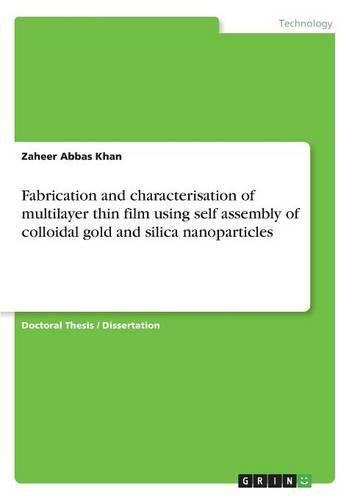Readings Newsletter
Become a Readings Member to make your shopping experience even easier.
Sign in or sign up for free!
You’re not far away from qualifying for FREE standard shipping within Australia
You’ve qualified for FREE standard shipping within Australia
The cart is loading…






Doctoral Thesis / Dissertation from the year 2011 in the subject Materials Science, Asian Insitute of Technology, language: English, abstract: A novel approach of multilayered thin film based on layer-by-layer deposition using colloidal nanoparticles was carried out in this work. The films were made by the self-assembly of oppositely charged metal and dielectric nanoparticles, alternately capped with polymers. Synthesized colloidal suspensions of gold nanoparticles ( 20nm) and silica nanoparticles ( 30nm) were used as the building blocks for the self-organisation of the films. Capping with PDDA and chitosan was used effectively to control the optical absorption of the surface plasmon resonance peaks of the gold nanoparticles. Using different combinations of layer formation, absorption characteristics in the near-ultraviolet (NUV), green and blue region were controlled through capping and varying the thickness of the film. Capping with chitosan or PDDA reduced the absorption peak of the coated silica nanoparticles in a similar fashion. Peak absorption in the UV range was achieved by assembling bare silica nanoparticles layers onto layers of gold nanoparticles. Transmission color was controlled (less than 1% color distance per added bi-layer) by changing the film thickness. Optical modeling of multilayer thin films constructed with oppositely charged nanoparticles helped us to understand phenomenon such as surface plasmon resonance, absorbance, transmittance and reflectance. Maxwell-Garnett effective medium theory in this case is applied in quasi-static limit to multilayer composite consisting of host material silica and inclusion material gold nanoparticles. Maxwell Garnett optical simulations is correlated with experimental spectra obtained for the thin film composites. The thickness of layers, size and spacing of metal inclusion is varied to alter the optical properties for the required device applications. The multilayered thin film of gold and silica resemble
$9.00 standard shipping within Australia
FREE standard shipping within Australia for orders over $100.00
Express & International shipping calculated at checkout
Doctoral Thesis / Dissertation from the year 2011 in the subject Materials Science, Asian Insitute of Technology, language: English, abstract: A novel approach of multilayered thin film based on layer-by-layer deposition using colloidal nanoparticles was carried out in this work. The films were made by the self-assembly of oppositely charged metal and dielectric nanoparticles, alternately capped with polymers. Synthesized colloidal suspensions of gold nanoparticles ( 20nm) and silica nanoparticles ( 30nm) were used as the building blocks for the self-organisation of the films. Capping with PDDA and chitosan was used effectively to control the optical absorption of the surface plasmon resonance peaks of the gold nanoparticles. Using different combinations of layer formation, absorption characteristics in the near-ultraviolet (NUV), green and blue region were controlled through capping and varying the thickness of the film. Capping with chitosan or PDDA reduced the absorption peak of the coated silica nanoparticles in a similar fashion. Peak absorption in the UV range was achieved by assembling bare silica nanoparticles layers onto layers of gold nanoparticles. Transmission color was controlled (less than 1% color distance per added bi-layer) by changing the film thickness. Optical modeling of multilayer thin films constructed with oppositely charged nanoparticles helped us to understand phenomenon such as surface plasmon resonance, absorbance, transmittance and reflectance. Maxwell-Garnett effective medium theory in this case is applied in quasi-static limit to multilayer composite consisting of host material silica and inclusion material gold nanoparticles. Maxwell Garnett optical simulations is correlated with experimental spectra obtained for the thin film composites. The thickness of layers, size and spacing of metal inclusion is varied to alter the optical properties for the required device applications. The multilayered thin film of gold and silica resemble